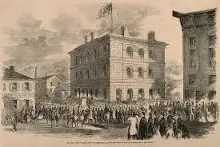The Making of the 50 States: West Virginia
Part 2: The Rest of the Story The state of Virginia grew into an economic powerhouse in the early 19th Century, but the western and eastern parts grew in different ways. The Appalachian Mountains, for the most part, separated the two parts of the state, which had grown somewhat separately in culture and economic focus. Salt, lumber, and coal have been major industries in the West. Politically, the western part of the state, nearly in its entirety, did not agree with the state's new constitution, drafted in 1850. As the century progressed, the two parts of the state were more and more different. One fundamental way in which the eastern part and western part of Virginia were different was in the attitude of residents toward slavery. Many Virginians living in the east favored the possibility of having slavery; indeed, many of them owned slaves. Many living in the west neither owned slaves nor countenanced anyone else owning them. Famed abolitionist John Brown led a raid on the federal arsenal at Harpers Ferry in 1859, with the stated intention of seizing the weapons there in order to precipitate a slave uprising. He and his men were captured (some were killed in the preceding firefight), and Brown was killed. 
When Virginia seceded from the Union, a large number of people who lived in the western part of the state did not support this move, which was countenanced after a state convention at the capital, Richmond. Instead, they called their own convention, in May 1861 at Wheeling, and proposed removing themselves entirely from the State of Virginia. The initial preference was not so radical. A second Wheeling convention two months later, resulted in what amounted to a separate state government and delegation to Congress. The Restored Government, as it was known, proposed to create the State of Kanawha, which would have included most of what is now the State of West Virginia. Troops of the Union Army drove Confederate troops out of most of the western part of the state, paving the way for a different kind of secession. The western state legislature voted in May 1862 to create a new state and applied to Congress for admittance. The reply was that the state constitution would have to include a provision for the abolition of slavery. After the adoption of a revised state On June 20, 1863, West Virginia became the 35th state in the Union; the capital was Wheeling. First page > In the Beginning > Page 1, 2 |
|
Social Studies for Kids
copyright 2002–2024
David White



 constitution, President
constitution, President 
